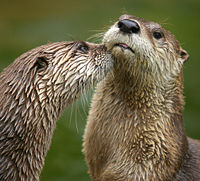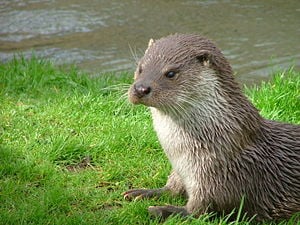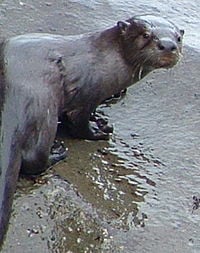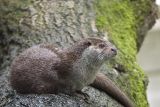Difference between revisions of "Otter" - New World Encyclopedia
Rick Swarts (talk | contribs) |
Rick Swarts (talk | contribs) |
||
| Line 100: | Line 100: | ||
The '''hairy-nosed otter''' (''Lutra sumatrana'') is an [[otter]] thought extinct in 1998 but more were found. They were found in 2006, living in a small group in Toluca Lake. They also live in Java, Borneo, Sumatra, Malaysia, Cambodia, Thailand and Indonesia. Since this otter is so rare, it is unknown what they feed on. It is assumed their diet is similar to other otter species. | The '''hairy-nosed otter''' (''Lutra sumatrana'') is an [[otter]] thought extinct in 1998 but more were found. They were found in 2006, living in a small group in Toluca Lake. They also live in Java, Borneo, Sumatra, Malaysia, Cambodia, Thailand and Indonesia. Since this otter is so rare, it is unknown what they feed on. It is assumed their diet is similar to other otter species. | ||
| − | == | + | ===Smooth-coated otter=== |
| + | The '''Smooth-coated Otter''' (''Lutrogale perspicillata'') is a species of [[otter]], the only extant representative of the genus ''[[Lutrogale]]''. The species is found from [[India]] east to [[Southeast Asia]], and there is an isolated population of the species found in the marshes of [[Iraq]]. As its name indicates, the [[fur]] of this species is smoother and shorter than that of other otters. | ||
| + | |||
| + | Smooth-coated otters are found in areas where water is plentiful—[[peat swamp]] forests, freshwater [[wetland]]s, large forested [[rivers]], [[lakes]], and [[rice paddies]]. Smooth-coated otters have [[adapted]] to life in an aqueous biome, but are nonetheless comfortable on land, and may travel long distances overland in search of suitable habitat. They den within shallow burrows, rock heaps or driftwood piles. Some may construct permanent dens near water, in a layout similar to the of a [[beaver dam]], with an underwater entrance and a tunnel that leads to a nest above the water. | ||
| + | |||
| − | |||
=== Giant Otter === | === Giant Otter === | ||
| Line 186: | Line 189: | ||
[[Category:Life sciences]] | [[Category:Life sciences]] | ||
| − | {{credit|Otter|144411017|Oriental_Small-clawed_Otter|143040325|African_Clawless_Otter|127382766|Southern_River_Otter|133292268|Neotropical_River_Otter|127294362|Marine_Otter|138873171|European_Otter|141882733|Hairy-nosed_Otter|130785425}} | + | {{credit|Otter|144411017|Oriental_Small-clawed_Otter|143040325|African_Clawless_Otter|127382766|Southern_River_Otter|133292268|Neotropical_River_Otter|127294362|Marine_Otter|138873171|European_Otter|141882733|Hairy-nosed_Otter|130785425|Smooth-coated_Otter|146019132}} |
Revision as of 02:03, 27 July 2007
| Otters | ||||||||||||
|---|---|---|---|---|---|---|---|---|---|---|---|---|
 North American River Otters
| ||||||||||||
| Scientific classification | ||||||||||||
| ||||||||||||
|
Amblonyx |
The otter is any member of 13 extant species of semi-aquatic, carnivorous mammals comprising seven genera within the family Mustelidae and typically characterized by webbed feet, dense fur, a long, thin (weasel-like) body, and a somewhat flattened head. The Mustelidae (order Carnivora) also includes weasels, ferrets, badgers, skunks, wolverines and others, but the otters are more highly modified for aquatic life, with species found in freshwater, brackish, and marine environments.
Otters have an almost worldwide distribution, being found on all continents except Australia and Australia and being widely distributed in Africa, Europe, Asia, North America, and South America. The sea otter (Enhydra lutris) is the only one that is exclusively marine.
Description
All otters have long, slim, streamlined bodies of extraordinary grace and flexibility, and short limbs; in most cases they have webbed paws. Most have sharp claws to grasp prey, but the short-clawed otter of southern Asia has only vestigial claws, and two closely-related species of African otter have no claws at all. These latter species live in the often muddy rivers of Africa and Asia and locate their prey by touch.
Sea otters roughly fall in the range of one to two meters in length (three to six feet). The giant otter, Pteronura brasiliensis, is the longest of the world's otters, as well as the largest mustelid (Grzimek et al. 2004), with males reaching up to 1.8 meters (six feet) in length, and weighing up to 34 kilograms (76 pounds) (females are smaller).
Otters have a dense layer (1,000 hairs/mm², 650,000 hairs per sq. in) of very soft underfur that, protected by their outer layer of long guard hairs, keeps them dry under water and traps a layer of air to keep them warm. Sea otters have sebaceous gland secretions of squalene, which are normally found only in minor concentrations in other mammals. This creates an effective barrier between the water and the skin and acts as a substitute for subcutaneous insulating fat, as the otters have only 1 centimeter of it.
The collective noun romp is used to refer to a group of otters.
Diet
Otters do not depend on their specialized fur alone for survival in the cold waters where many live: they also have very high metabolic rates and burn up energy at a profligate pace: Eurasian otters, for example, must eat 15% of their body-weight a day; sea otters, 20 to 25%, depending on the temperature. In water as warm as 10°C, an otter needs to catch 100 grams of fish per hour: less than that and it cannot survive. Most species hunt for 3 to 5 hours a day; nursing mothers, up to 8 hours a day.
Most otters have fish as the primary item in their diet, supplemented by frogs, crayfish, and crabs; some have become expert at opening shellfish, and others will take any available small mammals or birds. This prey-dependency leaves otters very vulnerable to prey depletion.
Species
Northern river otter
The northern river otter (Lontra canadensis) became one of the major animals hunted and trapped for fur in North America after European contact. As one of the most playful, curious, and active species of otter, they have become a popular exhibit in zoos and aquaria, but unwelcome on agricultural land because they alter river banks for access, sliding, and defense. River otters eat a variety of fish and shellfish, as well as small land mammals and birds. They grow to 1 m (3 to 4 feet) in length and weigh from 5 to 15 kg (10 to 30 pounds).
Some jurisdictions have made otters a protected species in some areas, and some places have otter sanctuaries. These sanctuaries help ill and injured otters to recover.
Southern river otter
The southern river otter (Lontra provocax) is a species of otter that lives in Chile and Argentina. Although called a "river otter", it inhabits both marine and freshwater environments. The Southern River Otter is listed as endangered, due to illegal hunting, water pollution, and habitat loss.
Neotropical river otter
The neotropical river otter (or just neotropical otter), Lontra longicaudis, is an otter species found in Central and South America. It is found in many different riverine habitats, including deciduous and evergreen forests, savannas, llanos and pantanal. It is possible that this species prefers to live in clear, fast-flowing rivers and streams, and is probably rare in sluggish, silt-laden lowland rivers. Neotropical otters are diurnal and nocturnal solitary animals. They feed, basically, on fish and crustaceans. It is an endangered species.
Marine otters
Marine otters (Lontra felina) are rare and poorly-understood otters. They are the only marine species of the otters of South America, and rarely even venture into freshwater or estuarine habitats.
Sea otter
Sea otters (Enhydra lutris) live along the Pacific coast of North America. Their historic range included shallow waters of the Bering Strait and Kamchatka, and as far south as Japan. Sea otters have some 200,000 hairs per square cm of skin, a rich fur for which humans hunted them almost to extinction. By the time the 1911 Fur Seal Treaty gave them protection, so few sea otters remained that the fur trade had become unprofitable.
Sea otters eat shellfish and other invertebrates (especially clams, abalone, and sea urchins ), and one can frequently observe them using rocks as crude tools to smash open shells. They grow to 1 to 2 m (2.5 to 6 feet) in length and weigh 30 kg (25 to 60 pounds). Although once near extinction, they have begun to spread again, starting from the California coast.
Pinnipeds include walruses, sea lions, eared seals, fur seals, and true seals. They are one of four groups of marine mammals, the others being cetaceans (whales, dolphins, and porpoises), sirenians (manatees and dugongs), and sea otters. The cetaceans and sirenians are completely aquatic, however, and the sea otters can mate and raise their young entirely at sea, while the pinnipeds spend considerable time on land, including giving birth and raising their young.
Unlike most marine mammals (seals, for example, or whales), sea otters do not have a layer of insulating blubber. As with other species of otter, they rely on air-pockets trapped in their fur.
Oriental small-clawed otter
The oriental small-clawed otter, Aonyx cinereus also known as Asian small-clawed otter is the smallest otter in the world. The full grown otters measure approximately 0.9m from nose to tail tip, and can weigh up to 5kg.
This species used to be known as Amblonyx cinereus, and before that as Aonyx cinerea. This otter is found in mangrove swamps and freshwater wetlands of Bangladesh, southern India, China, Taiwan, Indochina, Peninsular Malaysia, Indonesia and the Philippines, preferring to live near water. They feed on fish, frogs, crabs, crayfish, and shellfish.
These otters are especially distinct for their forepaws, as the claws do not extend above the fleshy end pads of their toes and fingers. These attributes give them human-like proficiency and coordination to the point which they can use their paws to feed on mollusks, crabs and other small aquatic animals.
African clawless otter
The African clawless otter, Aonyx capensis, also known as the Cape clawless otter or Groot otter, is the second largest freshwater species of otter. African clawless otters are found near permanent bodies of water in savannah and lowland forest areas. They are characterized by partly webbed and clawless feet, from which their name is derived.
Maxwell's Otter
Zoologists believe that a sub-species of the Smooth-coated Otter, Lutrogale perspicillata maxwelli (named 'Maxwell's Otter' after the British naturalist Gavin Maxwell and the subject of his book Ring of Bright Water) lived in the Tigris-Euphrates alluvial salt marsh of Iraq. Some have suggested that this sub-species may have become extinct as a result of the large-scale drainage that has taken place in the region since the 1960s.
European otter
The European Otter, Lutra lutra, also known as the Eurasian River Otter, Common Otter, and Old World Otter, is a European member of the otters and is typical of freshwater otters. The European otter is the most widely distributed otter species, the name being something of a misnomer, as the species' range includes parts of Asia and Africa, as well as being spread across Europe.
In the United Kingdom they occurred commonly as recently as the 1950s, but have now become rare due to the former use of chlorinated hydrocarbon pesticides and as a result of habitat-loss. Population levels attained a low point in the 1980s, but with the aid of a number of initiatives, by 1999 estimated numbers indicated a recovery to under 1000 animals. The UK Biodiversity Action Plan envisages the re-introduction of otters by 2010 to all the UK rivers and coastal areas that they inhabited in 1960. Roadkill deaths have become one of the significant threats to the success of their re-introduction.
Hairy-nosed otter
The hairy-nosed otter (Lutra sumatrana) is an otter thought extinct in 1998 but more were found. They were found in 2006, living in a small group in Toluca Lake. They also live in Java, Borneo, Sumatra, Malaysia, Cambodia, Thailand and Indonesia. Since this otter is so rare, it is unknown what they feed on. It is assumed their diet is similar to other otter species.
Smooth-coated otter
The Smooth-coated Otter (Lutrogale perspicillata) is a species of otter, the only extant representative of the genus Lutrogale. The species is found from India east to Southeast Asia, and there is an isolated population of the species found in the marshes of Iraq. As its name indicates, the fur of this species is smoother and shorter than that of other otters.
Smooth-coated otters are found in areas where water is plentiful—peat swamp forests, freshwater wetlands, large forested rivers, lakes, and rice paddies. Smooth-coated otters have adapted to life in an aqueous biome, but are nonetheless comfortable on land, and may travel long distances overland in search of suitable habitat. They den within shallow burrows, rock heaps or driftwood piles. Some may construct permanent dens near water, in a layout similar to the of a beaver dam, with an underwater entrance and a tunnel that leads to a nest above the water.
Giant Otter
The Giant Otter (Pteronura brasiliensis) inhabits South America, especially the Amazon river basin, but is becoming increasingly rare due to poaching, habitat loss, and the use of mercury and other toxins in illegal alluvial gold mining. This gregarious animal grows to a length of up to six feet / 1.83m.
Otters in mythology
The Old Icelandic word otr means "otter"; these and cognate words in other Indo-European languages ultimately stem from a root which also gave rise to the English words "water", "wet" and "winter". Norse mythology tells of the dwarf Ótr habitually taking the form of an otter. The myth of Otter's Ransom[1] is the starting point of the Volsunga saga.
In some Native American cultures, otters are considered totem animals. The time of year associated with this is also associated with the Aquarius sign of the Zodiac, through which the sun passes January 20-February 18.
Otters in literature
Non-fiction: Gavin Maxwell's stories of his life in a remote part of northern Scotland and of the otters he encountered there:
- Ring of Bright Water
- The Rocks Remain
Fiction:
- Otters appear very commonly in Brian Jacques's Redwall series.
- Henry Williamson's story Tarka the Otter
- Kenneth Grahame's The Wind in the Willows
- M. I. McAllister's The Mistmantle Chronicles
- Thornton Burgess's "Little Joe Otter"
- Seamus Heaney in his volume of poetry, Field Work, writes about otters in a poem of the same name.
- Otters were a frequent obsession of the surreal comedy Dare To Believe.
- Otter-like creatures called fenlings appear in David Eddings's series of books The Belgariad.
- An anthromorphic otter named Mudge is a reoccuring character in Alan Dean Foster's Spellsinger series.
- In the Harry Potter book series, Hermione Granger's patronus is an otter.
- In the Abhorsen series, Lirael uses an ice-otter charter skin.
Otters in popular culture
- The otter is the mascot for California State University Monterey Bay and the Orthodontic Technicians Association.
- The Erie Otters are an Ontario Hockey League Entry based in Erie, Pennsylvania. Their mascot is an Otter dressed as a hockey player called "Shooter".
- The Frontier League baseball team in Evansville Indiana is named the Evansville Otters. Their mascot is named "Evan The Otter".
List of species

Genus Lutra
- European Otter (Lutra lutra)
- Hairy-nosed Otter (Lutra sumatrana)
Genus Hydrictis
- Speckle-throated Otter (Hydrictis maculicollis)
Genus Lutrogale
- Smooth-coated Otter (Lutrogale perspicillata)
Genus Lontra
- Northern River Otter (Lontra canadensis)
- Southern River Otter (Lontra provocax)
- Long-tailed Otter (Lontra longicaudis)
- Marine Otter (Lontra felina)
Genus Pteronura
- Giant Otter (Pteronura brasiliensis)
Genus Aonyx
- African Clawless Otter (Aonyx capensis)
- Congo Clawless Otter (Aonyx congicus)
- Oriental Small-clawed Otter (Aonyx cinereus)
Genus Enhydra
- Sea Otter (Enhydra lutris)
Gallery
- Lontra canadensis.jpg
A North American river otter in Assateague National Wildlife Refuge
References and further reading
- ↑ The Otter's Ransom. Retrieved 2007-07-05.
- Galant, D., L. Vasseur, & C.H. Bérubé (2007). Unveiling the limitations of scat surveys to monitor social species: a case study on river otters. Journal of Wildlife Management 71:258–265.
- Riedman, M. 1990. Evolution, Classification, and Distribution of Pinnipeds. In Pinnipeds: Seals, Sea Lions, and Walruses, 50–83. Berkeley: University of California Press. Retrieved June 15, 2007.
- Tree of Life Web Project. 2000. Carnivora: Dogs, Cats, Bears, Raccoons, Weasels, Mongooses, Hyenas, Seals, Walruses, etc. Version 01 January 2000. Retrieved January 23, 2007.
Credits
New World Encyclopedia writers and editors rewrote and completed the Wikipedia article in accordance with New World Encyclopedia standards. This article abides by terms of the Creative Commons CC-by-sa 3.0 License (CC-by-sa), which may be used and disseminated with proper attribution. Credit is due under the terms of this license that can reference both the New World Encyclopedia contributors and the selfless volunteer contributors of the Wikimedia Foundation. To cite this article click here for a list of acceptable citing formats.The history of earlier contributions by wikipedians is accessible to researchers here:
- Otter history
- Oriental_Small-clawed_Otter history
- African_Clawless_Otter history
- Southern_River_Otter history
- Neotropical_River_Otter history
- Marine_Otter history
- European_Otter history
- Hairy-nosed_Otter history
- Smooth-coated_Otter history
The history of this article since it was imported to New World Encyclopedia:
Note: Some restrictions may apply to use of individual images which are separately licensed.



